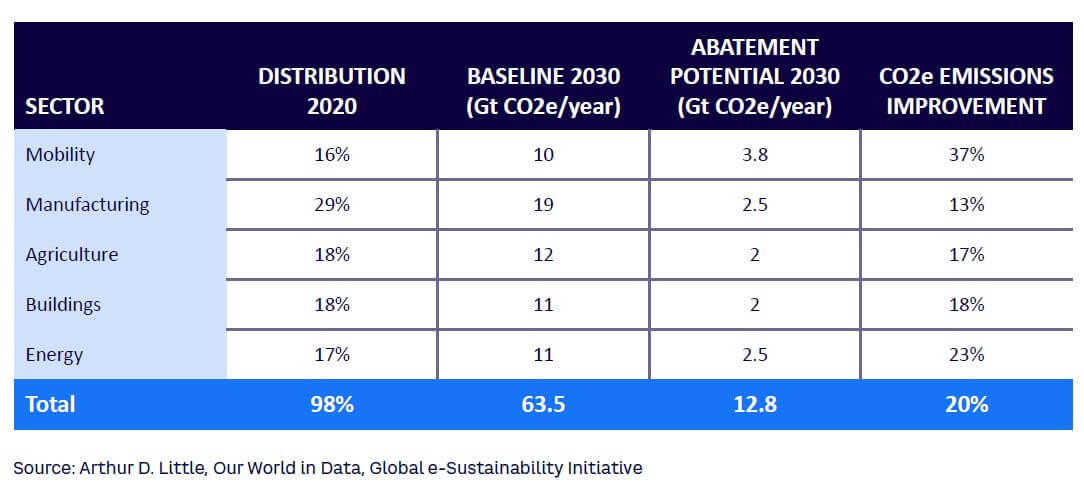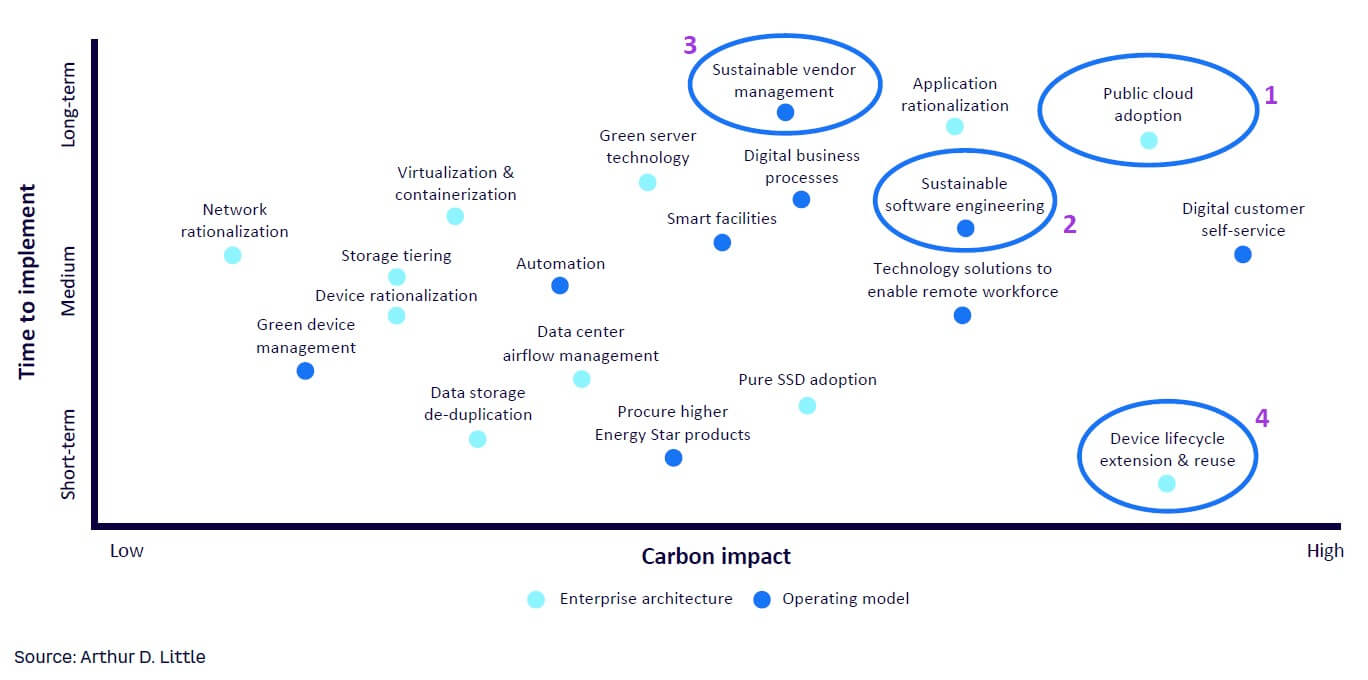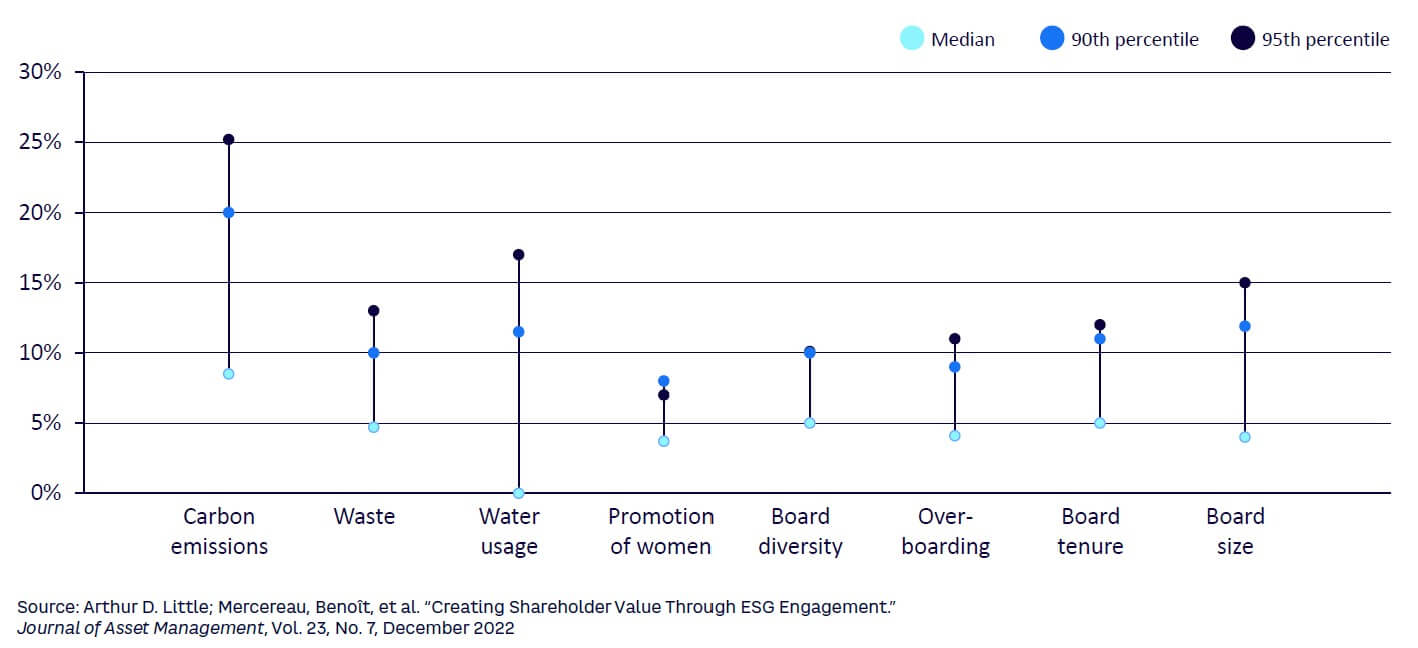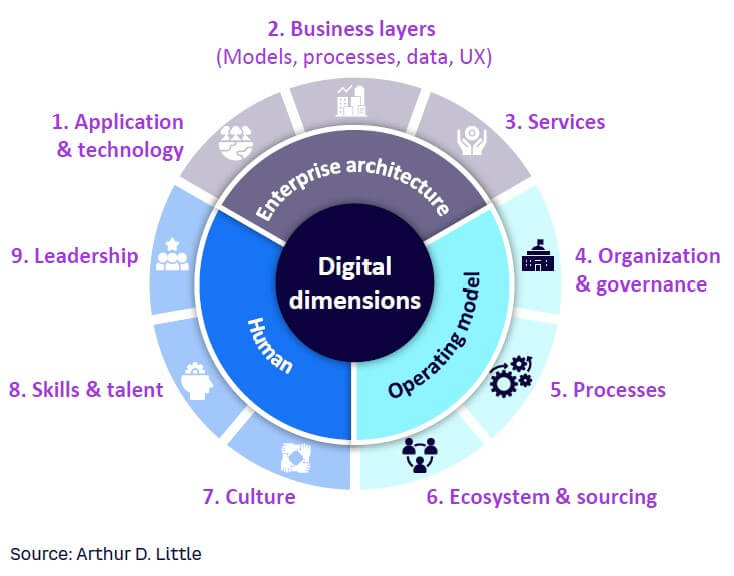
Digitalization and sustainability are top priorities for large companies and investors that increasingly are becoming inseparable. Digital technologies are central to company transformation and key for managing sustainability footprints. At the same time, these technologies can themselves be significant contributors to greenhouse gas (GHG) emissions. Since choices on either side impact the other, sustainability and digitalization decisions should be addressed together. In this Viewpoint, we show why corporations should place the integration of sustainability and digitalization at the top of their agenda, not just to meet stakeholder expectations but also to boost company value.
THE IMPACT OF DIGITALIZATION ON SUSTAINABILITY
Digitalization & sustainability have become top value drivers for business
In today’s uncertain business environment with rising inflation, geopolitical risks, higher interest rates, and recession threats, digitalization and sustainability have truly risen to the top of the agenda. In a 2023 Arthur D. Little (ADL) global survey of 246 CEOs of large companies with revenues over US $1 billion (see ADL’s latest CEO Insights Report, “Turning Turmoil to Advantage: How CEOs Are Navigating Change to Drive Growth”), sustainability was found to be the top most impactful driver affecting growth, followed by digital technologies, including artificial intelligence (AI), automation, and robotics. Over 80% of CEOs now view environmental, social, and governance (ESG) as a source of competitive advantage. These results are also confirmed by the Forbes 2023 “State of Sustainability” survey, in which the share of companies that consider sustainability a priority rose from 26% to 43% in the last three years.
The same is true from an investor perspective, where operational improvement through digitalization remains the top operational lever for private equity (PE) firms to enhance the value of their portfolio companies. For example, in a 2022 ADL/Invest Europe joint survey (see “The Insight: Keeping an Eye on the Horizon”), over two-thirds of PE firms selected digitalization as the top lever, followed by acquisition. In the same survey, over 80% of PE firms expected ESG to increase in importance for daily operations, with new rules such as the Sustainable Finance Disclosure Regulation seen as creating new opportunities for the PE industry to deliver on climate and ESG results.
Understandably, digitalization and sustainability initiatives feature heavily in the strategies of investors and large companies looking to grow company value. However, in most organizations, these initiatives are still managed separately within different functions. This approach is becoming increasingly ineffective as digitalization and sustainability are rapidly converging, linked both in terms of management controls and impact. In this Viewpoint, we look in more depth at these linkages and how “digital sustainability” should be managed in an integrated way, not just to meet regulatory and stakeholder expectations, but also to significantly enhance business value.
How digitalization & sustainability are inextricably linked
Essentially, there are two opposing dimensions to the linkages between digitalization and sustainability:
-
Digitalization to help manage sustainability.
-
Sustainability impacts caused by digitalization.
Digitalization to help manage sustainability
This dimension is concerned with how digital technologies, processes, and ways of working can help organizations better manage the sustainability impacts of their operations. We focus primarily on environmental sustainability impacts related to business operations, including GHG emissions as well as other key concerns like circularity, resource usage (e.g., water, energy, and scarce natural raw materials), and preserving biodiversity. Of course, digital technologies impact other aspects of sustainability as well, including social well-being, inclusion, health, and welfare.
In general, digitalization helps to manage sustainability by providing real-time operational data and information on the impacts of a business’s processes and activities. This data and information can be gathered through, for example, Internet of Things (IoT) and conventional enterprise resource planning system technologies, processed and analyzed with the help of data analytics, AI, and simulation technologies, and acted upon either through automation or manual interventions. This level of data and control is essential for a business to effectively manage its whole-life environmental footprint, including activities upstream and downstream of its operations. Businesses require future-ready data governance and data management capabilities, including IT infrastructure that enables data transparency and sovereignty, to address sustainability needs across the full value chain.
Analyzing publicly available sector emission data in combination with the demonstrated potential of digital technologies to reduce these emissions uncovers significant improvement potential. Using digital technologies to gain visibility into, and subsequently optimize, a company’s environmental impact can achieve between ~10% and ~40% GHG reduction potential in company-wide footprint, depending on the sector (see Table 1). Table 1 provides insight into the projected baseline CO2 equivalent (CO2e) emissions by 2030 across selected industry sectors with the reduction potential in applying various digital technologies. The results reveal potential relative reductions across various use cases, which we will elaborate on in this Viewpoint.

Sustainability impacts caused by digitalization
In addition to enabling better management of sustainability, digitalization gives rise to some significant negative sustainability impacts that arise from two primary sources:
-
Many digital and IT hardware devices use significant quantities of rare natural resources and generate a large amount of waste, currently estimated at more than 50 million metric tons (Mt) per year, according to Statista. Continuing at the same pace, the UN Environment Programme estimates this will reach 120 Mt/year by 2050. And Statista reports that only ~17% of this waste is currently recycled.
-
Digital software and applications are extremely energy intensive. On a global scale, studies have shown that digital technologies now contribute between 2%-4% of global GHG, which the European Commission expects will increase to 14% by 2040. The cloud now has a greater carbon footprint than the airline industry, with a single data center sometimes consuming the equivalent electricity of as many as 50,000 homes.
The relative importance of one dimension versus the other depends on a company’s digital intensity and, in most cases, can be generalized per industry based on factors such as whether the industry is product- or service-based and the energy-intensivity of its operations. For example, in financial services, which is technology- and data-intensive, digital technology is often in the top three sources of GHG emissions, along with corporate fleets and facilities. On the other hand, for companies in manufacturing and heavy processing industries, digital technology constitutes only a small portion of the total footprint, so more can be achieved by focusing on how digitalization can improve manufacturing operations.
Due to these differences, digitalization strategies must properly integrate sustainability factors or risk being inadequate going forward. Similarly, sustainability strategies that do not consider digitalization run the risk of missing out on key levers to manage impact and underestimating the sustainability impacts of digitalization itself.
WHAT ARE THE LEVERS FOR MANAGING IMPACT?
In this section, we explore in more detail what businesses can do to manage these two dimensions and provide some illustrative case examples.
Key levers for using digitalization to help manage sustainability
A number of digitalization levers exist for application across different business functions, including:
-
Supply chain and production management. Connected digital twins of products and production facilities can be used to optimize both operational and sustainability performance. Examples include enhancing product and process design to improve circularity, monitoring energy usage and carbon emissions in production processes, materials tracking and tracing (see, for example, “The Global Battery Alliance [GBA) Battery Passport”), sustainability reporting, and lifecycle assessment and improvement. For many companies, digital twins is the next step in the digital transformation journey, requiring substantial investment but delivering huge benefits.
-
Supplier management. Digital technologies also have the potential to help manage environmental footprints up and down the supply chain involving third parties, such as suppliers and partners (usually referred to as scope 3 emissions). Digital connectivity and data sharing with third parties can enable greatly improved visibility of end-to-end sustainability impacts, although such data sharing typically involves overcoming various institutional and technical barriers. This aspect is covered in more detail in ADL’s recent joint report with Cefic for the chemicals industry (see “Digital Technologies for Sustainability in the European Chemical Industry”).
-
Facilities management. One of the simplest areas to consider, videoconferencing and virtual collaboration/meeting/training tools can be used to reduce the need for travel. Digital technologies can also be used to monitor and control energy consumption in buildings. Using smart lighting, heating, and cooling systems can also reduce energy consumption.
-
Document management. Integrated systems with e-signature and document sharing reduce the need for paper-based records and printing, at the same time reducing paper waste and also saving energy on producing, transporting, and storing physical documents.
In addition to levers that are available today, there is huge potential in the coming years to exploit developing digital technologies in a more holistic way in the context of the Industrial Metaverse. The most significant development is the extension of the digital twin concept beyond discrete physical assets, such as factories or products to include digital twins of whole end-to-end industrial systems, ultimately including business processes and human resources as well as operations. This will provide the opportunity for management to conduct data-driven “what-if” scenarios to inform forward-looking strategic decision-making, integrating sustainability impacts fully with commercial, financial, and operational issues. We estimate that it will be several years before these whole-system digital twins are likely to be feasible more broadly. (ADL’s Blue Shift Institute is planning an in-depth report on the Industrial Metaverse in 2023.)

Key levers for reducing the sustainability impacts of digitalization
Figure 1 shows how companies can use a mix of measures to reduce their corporate GHG footprint, plotted in terms of time to implement and potential carbon impact (below we highlight four initiatives circled in Figure 1).

A good starting point is to conduct an assessment of the relative contribution of different aspects of the digital and IT function to the company’s sustainability footprint. On a high level, these aspects relate to a company’s hardware efficiency in terms of power and cooling, compute efficiency, software engineering practices being used, and the vendor management for digital and IT services:
-
Hardware efficiency. Energy used to power and cool corporate data centers makes them often one of the top sources of corporate GHG emissions, producing 300 million tons of CO2 across the globe each year, according to the International Energy Agency, and consuming 2% of electricity, projected to reach 8% by 2030. In some cases, this represents up to half of a company’s carbon footprint. Companies can reduce emissions through use of more efficient cooling systems and hardware (optimizing its energy efficiency, typically known as “power usage effectiveness”). Energy sourcing can also be optimized toward exclusively renewable sources. Additionally, there may be opportunities to reuse energy for district heating or hot water, if feasible. For example, Facebook’s data center in Denmark supplies hot air waste to the district heating system of the nearby city of Odense, the country’s third largest city — enough to warm 7,000 homes.
-
Compute efficiency. On top of the efficiency of the hardware itself, optimizing the infrastructure’s run phase is critical, as this is often the most energy-intensive part of the lifecycle. Impacts can be minimized by implementing new ways of working and user-awareness campaigns. Maximizing server utilization through sharing servers and hardware throughout a company and with other companies (i.e., virtualization and consolidation) is an effective way to ensure that capacities are fully used, optimizing usage of existing compute estate.
-
Cloud footprint (Initiative 1, Figure 1). Increasing the migration of IT services to the cloud may also offer sustainability benefits, as many cloud service providers have already reduced GHG footprints. The choice of cloud service provider is therefore also an important consideration. Cloud service providers across the world face particular sustainability challenges as cloud data volumes continue to grow. Locating data centers in regions of the world where more natural cooling and/or more renewable energy sources are available is one effective longer-term strategy, among others.
-
Sustainable software engineering (Initiative 2). Opportunities exist for most companies to manage the development and deployment of software and applications more responsibly, minimizing the required demands on servers and data centers. For example, Forbes reports that as much as 80% of functionalities in a typical cloud software product are never or rarely used, and training a single AI model can emit as much carbon as five cars emit over their lifetimes. Interpreted languages (e.g., Python and NodeJS) consume 10 times more energy than semi-compiled languages (e.g., Java and C#) and 48 times more energy than compiled languages (C, C++).
-
Sustainable vendor management (Initiative 3). As a large portion of company IT is typically procured or outsourced, managing the sustainability impacts of digitalization also requires an end-to-end perspective beyond the company boundaries to gain a realistic picture of the footprint. In particular this means also considering a company’s vendors, service and cloud providers and enforcing sustainability standards on those.
The advent of energy-hungry AI solutions (e.g., large language models) and rollout of large-scale blockchain solutions are definitely important to consider. Often, these solutions come with a larger-than-expected contribution to company footprint. For example, when training even relatively simple AI models, tuning certain model-training parameters to achieve a 2% additional accuracy on a baseline of 95% typically results in a nearly 700% jump in energy consumption, according to ADL analysis. Likewise, large-scale blockchain solutions act as distributed databases where data essentially is duplicated, increasing the energy required to store and transfer data.
In addition to direct GHG generation during operations, companies must also focus on improving circularity in their use of IT hardware and equipment. This starts with selecting IT products designed with circularity in mind and includes extending their life through efforts like reuse, resale, repair, refurbishment, and remanufacturing in order to unlock the full embedded value (Initiative 4). However, progress in achieving circularity can be difficult for individual companies in the absence of national and/or regional regulations.
IMPROVING DIGITAL SUSTAINABILITY TO ENHANCE BUSINESS VALUE
The links between digital sustainability & company value
As we mentioned at the start of this Viewpoint, the drivers for digital sustainability are self-evident to meet both regulatory and broader stakeholder expectations. Companies also have a clear ethical responsibility to contribute to a net-zero world, irrespective of other considerations. However, it is only recently that the direct linkages between digital sustainability and business valuation have become clear.
Considering sustainability alone, evidence shows that adopting best ESG practices leads to an increase in company valuation. An example shown in Figure 2 demonstrates increases in company value resulting from best practice adoption across a range of ESG topics, including carbon emissions, waste, and water usage.
As Figure 2 illustrates, increases in company valuation of between 7% and over 25% result from adoption of median and 95th-percentile best practices in carbon emissions, respectively (the sample for the analysis includes more than 2,200 companies across all industries worldwide).

Focusing on the energy industry, up to 23% emissions reduction is possible through the use of digital technologies (as shown in Table 1). Using a data sample of 300 large energy companies with their price-to-earnings ratio (P/E) and environmental score, ADL analysis shows that a 5%-10% increase in company valuation[1] can be achieved through technology-enabled sustainability improvement. Taking an integrated approach that delivers outcomes and impacts for both dimensions — using digital to improve and reducing the impacts of digital itself — means that the potential for company value enhancement will be even greater. Indeed, we can see that digital sustainability is becoming one of the most effective value creation investments, as well as being an essential part of corporate responsibility.
How companies should go about improving their digital sustainability
Companies that have not yet integrated sustainability into their digitalization strategies should take action to do so. We recommend a basic four-step approach:
-
Audit of digital sustainability performance. The first stage is to conduct an audit of the company’s digital sustainability performance. This means breaking down the digital/IT estate into its various elements and considering their sustainability impacts, both negative and positive. As we have described, determining negative impacts requires considering aspects like hardware efficiency, utilization, software engineering, vendor management, and circularity. Positive impacts include production management, supplier management, and facilities management. The audit should also include some consideration of the potential of digital twins to enhance both operational and sustainability performance.
-
Identify and prioritize use cases. Once the audit has established the baseline, the next step is fleshing out the most significant opportunities and use cases. Typically, this will involve exploring potential solutions, costs, benefits, interfaces, barriers, and implementation roadmaps. As with all such change programs, some prioritization will be necessary based on consideration of certain aspects, such as impact achieved (i.e., sustainability impact and company value impact), level of investment required, linkages with other initiatives, and ease of implementation.
-
Integrate sustainability into digital strategy. Having clarified the feasibility and attractiveness of a range of opportunities and use cases, it is possible to meaningfully integrate sustainability into the company’s digital strategy. This integration is key to ensuring value creation and the capture of opportunities as digital transformation proceeds. The integration must tackle three major focus areas (Figure 3 illustrates the dimensions to consider):
-
First, the enterprise architecture considers the major technologies and digital services with a direct impact on emissions. Green technologies, reusability, and modularity of the technology landscape are key in this focus area.
-
Second, the digital operating model describes how the organization works in order to achieve the sustainability objectives.
-
Third — and most important — people are key for a successful sustainability strategy. The strategy can exploit its full potential only if the organization’s cultural mindset fully supports the sustainability endeavor. It is crucial that employees are aware of and understand this impact of digitalization so they can act on it and support the company’s sustainability ambition.
-
-
Pilots and quick wins. A portfolio approach involving rapid “quick win” projects and early pilots to build learning is helpful to ensure that momentum is maintained. Reviewing device lifecycles or investigating the data center and cloud energy usage and mix is often a good place to start.

Conclusion
INTEGRATING SUSTAINABILITY INTO DIGITALIZATION SHOULD BE HIGH PRIORITY
Sustainability and digitalization have increasingly converged as companies have progressed along their digital transformation journeys. A company that fails to recognize and leverage these linkages risks failing to deliver the full potential of digital investments. It may also mean its progress toward net zero is too slow to meet stakeholder expectations. And, in a very direct way, companies may miss out on one of the most effective methods available to them to boost company value. Integration should therefore be high on the executive agenda and should include a focus on five key elements:
-
Understand current performance on digital sustainability and obtain the organization baseline.
-
Define digitalization use cases that help to manage sustainability, in line with areas having the biggest footprint in the organization.
-
Prioritize levers and define initiatives for reducing sustainability impacts of digitalization, taking into account enterprise architecture, operating model, and human aspects.
-
Understand expected impact on valuation of defined initiatives and communicate appropriately in terms of company ambition, priorities, and ESG reporting.
-
Execute iteratively and track progress frequently versus the established baseline.
Note
[1] Based on a found correlation range of 0.05 to 0.13 with 95% confidence for impact of ESG score on P/E ratio.

